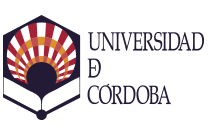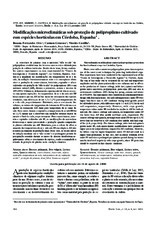Modificações microclimáticas sob proteção de polipropileno cultivado com espécies hortícolas em Córdoba, Espanha
Microclimatic modifications under polypropylene protection for horticultural crops in Córdoba, Spain
Autor
Fernandes Otto, Rosana
Giménez Padilla, Carmen
Castilla, Nicolás
Editor
Associação Brasileira de Horticultura (Brasilia)Fecha
2000Materia
Brassica pekinensisBeta vulgaris
Lactuca sativa
Spinacia oleracea
Plant protection
Leaf area
Vegetable biomass
METS:
Mostrar el registro METSPREMIS:
Mostrar el registro PREMISMetadatos
Mostrar el registro completo del ítemResumen
A cobertura de plantas com o material “não tecido” de
polipropileno constitui uma das técnicas mais recentes utilizada para
proteção de cultivos hortícolas. Dentro deste tema, foram conduzidos
quatro experimentos na área experimental do “Centro de
Investigación y Desarrollo Agrario”, em Córdoba, Espanha. Avaliou-
se a amplitude das modificações das temperaturas do ar e do
solo, da radiação fotossinteticamente ativa e o conseqüente efeito
sobre a produção de couve-chinesa, beterraba, espinafre e alface
cultivados sob proteção do “não tecido” de polipropileno (PP) e em
ambiente natural (AN), durante a primavera, outono e inverno de
1995/1996. Utilizou-se delineamento experimental de blocos ao acaso
com quatro repetições. As temperaturas do ar e do solo sob PP
foram maiores que em AN na fase inicial de crescimento das espécies
estudadas, com diferenças de até 5,5 e 2,2oC para temperaturas do
ar e do solo, respectivamente. Entretanto, com o crescimento das
culturas, os valores de temperatura do tratamento PP tenderam a se
igualar ao tratamento AN, tanto para temperatura do ar como do
solo. Para couve chinesa e espinafre, a temperatura do ar sob PP foi
até 3,1oC menor que a observada em condições naturais depois da
metade e final do ciclo, respectivamente. Para couve-chinesa, beterraba
e espinafre cultivados sob PP, as modificações do microclima
favoreceram a maior precocidade e produção quando comparadas
às plantas cultivadas em AN. Entretanto, para a cultura da alface o
aumento das temperaturas do ar e solo sob PP em relação a AN não
resultou em aumento da produção final. Neste caso, os baixos níveis
de radiação incidente sob o “não tecido” e o prolongado período de
precipitação ocorrido durante os meses de inverno interferiram negativamente
sobre o crescimento da espécie, sendo recomendado a
retirada da proteção de plantas nesta condição climática. Plants cover with a nonwoven polypropylene protection comprises
one of the most recent techniques for protecting horticultural crops.
Four experiments have been conducted at the experimental area of the
“Centro de Investigación y Desarrollo Agrario” in Córdoba, Spain.
The aim of this study was to evaluated the air and soil temperature
amplitudes and the photosynthetically active radiation and its effects
on the production of chinese cabbage, table beet, spinach and lettuce
grown under nonwoven polypropylene protection (PP) and also at
environment conditions (AN) during the spring, autumn and winter
of 1995/1996. The experiments were carried out in a randomized blocks
design with four replications. Air and soil temperatures under PP were
higher than those ones at AN conditions during initial growth period
for all studied species, with differences up to 5.5 and 2.2oC for air and
soil temperature, respectively. However, with crops growth,
temperature values under PP trended to be similar to AN for both air
and soil. For chinese cabbage and spinach, air temperature under PP
was lower than AN after middle and final cycle, respectively. For
chinese cabbage and spinach, air temperature under PP was up to 3.1oC
lower than the observed at AN condition after middle and final stage
of the cycle, respectively. For chinese cabbage, table beet and spinach
grown under PP, such microclimatic modifications have promoted a
higher precocity and production compared to AN conditions. However,
for lettuce crop the higher temperature under PP did not result in a
higher final production. In this case, low incidence radiation levels
under PP and also a prolonged precipitation period during the winter
months interfered negatively with crops growth, where PP protection
should be removed in this climatic conditions.

